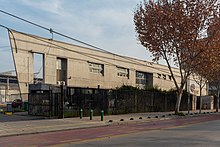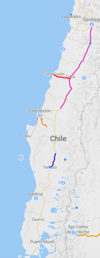 | |
 EFE headquarters in Santiago pictured in 2022 EFE headquarters in Santiago pictured in 2022 | |
| Company type | S.A. |
|---|---|
| Industry | Railway |
| Founded | 1884; 141 years ago (1884) |
| Headquarters | Santiago, Chile |
| Area served | Chile |
| Key people | Eric González (President) |
| Services | Freight transport |
| Owner | Government of Chile |
| Number of employees | 1817 (2022) |
| Parent | Ministry of Transportation |
| Website | efe.cl |
Empresa de los Ferrocarriles del Estado (abbreviated EFE, lit. State Railway Company) is the national railway and the oldest state-run enterprise in Chile. It manages the infrastructure and operating rail services in the country.
Track gauge
Main article: Track gauge in ChileThe track gauge is Indian gauge 1,676 mm (5 ft 6 in) in the south and 1,000 mm (3 ft 3+3⁄8 in) metre gauge in the north. The Santiago Metro uses 1,435 mm (4 ft 8+1⁄2 in) standard gauge.
History
Main article: History of rail transport in Chile
The company was created on January 4, 1884 by means of the purchase of the companies that exploited the longitudinal routes and the Santiago – Valparaíso route. Since then, the company acquired the railways of the sodium nitrate mining companies in the north of Chile. From 1913 on the network of the EFE extends from Iquique to Puerto Montt. Apart from the company, Chilean Army also built a 60 kilometres (37 mi) small rail line, known to be Puente Alto-El Volcan Railway for Military purpose to safeguard from Argentina attacks, which were opened in 1914 and closed during 1985. (more translation from es:Empresa de los Ferrocarriles del Estado#Historia to come)
A stable political and economic climate allowed EFE to start its largest-ever investment programme during the administration of Ricardo Lagos. This involved the spending of US$1 billion between 2003 and 2005, in order to increase capacity on commuter networks and improved long-distance services, as well as reconnecting Santiago with Puerto Montt via Temuco. Unfortunately, the project was involved in a series of corruption scandals and bad administration. The long-distance service trains, bought from the Spanish railway company RENFE, had serious flaws, and the service to Puerto Montt was closed some months later. This situation, triggered investigations from the government, who exposed the crisis of the company due to the administration mistakes.
During the last decade, the company has been revitalized, thanks to the state investments during the administrations of Michelle Bachelet and Sebastián Piñera, as well as the reestablishment and renovation of old routes, complemented with the integration of some of this routes with the Santiago, Valparaíso and Concepción public transport systems.
Subsidiaries
Passenger rail

- Metro Regional de Valparaíso (MERVAL S.A.): Commuter rail on the Valparaíso Region
- Operates the Valparaíso Metro, the commuter trains between Puerto Station in Valparaiso and Limache Station on the Valparaíso Region.
- Ferrocarriles Suburbanos de Concepción (Fesub Concepción S.A.): Commuter rail on the Biobío Region and Araucanía Region
- Operates the Biotren, the commuter service trains between Talcahuano's Mercado Station and Hualqui, and from Concepción Station to "Lomas Coloradas" Station in San Pedro de La Paz on the Biobío Region.
- Operates the Corto del Laja, the commuter service trains between Talcahuano and Laja, on the Biobío Region.
- Operates the Victoria-Temuco Regional Train, the commuter service train on the Araucanía Region.
- Trenes Metropolitanos: Commuter rail between the Santiago Metropolitan Region and the O'Higgins Region.
- Operates the Metrotrén, the commuter trains between Santiago to San Fernando and Rancagua.
- Servicio de Trenes Regionales Terra: Inter-city rail between the Santiago Metropolitan Region and the Ñuble Region.
- Operates the TerraSur, the Inter-city rail service between Santiago and Chillán.
- Operates the Regional Train Constitution-Talca Ramal between Constitución and Talca, in the Maule Region
Freight services

- Ferrocarril del Pacífico (FEPASA): Cargo between the Valparaíso Region and the Los Lagos Region.
- Transporte Ferroviario Andrés Pirazolli (TRANSAP): Cargo on the Santiago Metropolitan Region, O'Higgins Region and the Biobío Region.
- Ferronor: Metre gauge cargo line in the northern part of the country
- Ferrocarril de Arica a La Paz
Special tourist services
Future expansion
Proposed future rail infrastructure includes a new, more direct rail line between Santiago and Valparaíso, and expansions of Santiago's commuter rail network to Melipilla and Batuco.
Rail links with adjacent countries
- Bolivia - same gauge 1,000 mm (3 ft 3+3⁄8 in) - from Arica to La Paz, Bolivia and from Antofagasta to Uyuni, Bolivia
- Argentina - Transandine Railway - abandoned 1984 – 100 km of mountain railway of 1,000 mm (3 ft 3+3⁄8 in) gauge with rack railway sections - break of gauge 1,676 mm (5 ft 6 in)/1,000 mm (3 ft 3+3⁄8 in) at either end. Concession planned to re-open line.
- Another line connecting two countries is the Salta-Antofagasta, single 1,000 mm (3 ft 3+3⁄8 in) gauge.
- Peru - a single 1,435 mm (4 ft 8+1⁄2 in) standard gauge connection, the Tacna-Arica Railway, between the northern Chilean city of Arica and Tacna in Southern Peru. The line closed in 2012, but as of June 2014, there were plans to reopen it. The line has been put back into operation in February 2023.
See also
References
- "Historia del Ferrocarril en Chile" de Ian Thomson y Dietrich Angerstein, DIBAM, 2000.
- Article "Trenes de Ciudad" by Marco Sandoval O., Magazine "En Tren" nº 9, ACCPF, 2001
- "Reglamento Interno del Ferrocarril Militar de Puente Alto al Volcán", Instituto Geográfico Militar, 1934
- Apuntes de la Historia del Ferrocarril de Puente Alto a El Volcán, de Gonzalo Iglesias
- ^ John Kolodziejski (April 1, 2006). "Record investment boosts EFE's passenger business". Railway Gazette International. London.
- Thomas Salt (April 1, 2006). "Automation gets the most out of mining railway infrastructure". Railway Gazette International. London.
- "Tacna – Arica reopening studies". Railway Gazette International. Retrieved 3 July 2014.
External links
| Rail transport in South America | |
|---|---|
| Sovereign states | |
| Dependencies and other territories | |